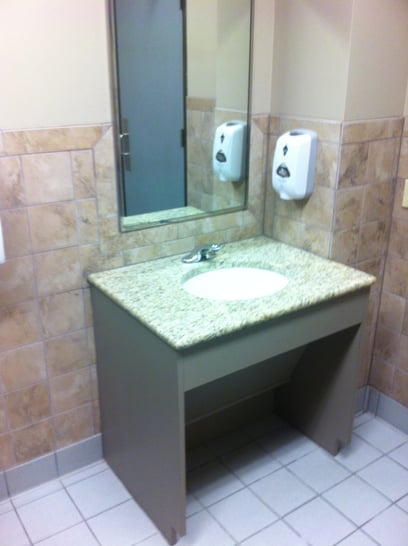Everyone is living longer only to experience many life-challenging events during an extended lifespan.The desire to remain in your current home is not driven by age. This need is a reaction to and the result of life's experience. Any family living with a disability among any of its family members will always benefit from familiar surroundings. To increase safety and independence within your current home, certain modifications to increase accessibility and use are typically required. These modifications include but are not limited to wider doorways, the installation of ramps, inclusive kitchen modifications, accessible bathroom modifications, and the application of smooth, non-skid flooring. When planning on what modifications are needed, always make a list of the home's most problematic areas for any or all of its residents. This basic desire is creating unprecedented nationwide challenges and a niche market in the remodeling industry known as Aging in Place. The majority of Americans over the age of 45 want to continue living in an environment they are well acquainted with throughout their maturing years. These people are looking for safety, security, ease of use, and comfort for their forever home before they must vacate due to specialized needs.

But where did this commonly seen lack of home accessibility in nearly all homes come from? Perpetual, status quo building techniques, and affordability provide the answers. Over time, along with the exponential birth rate of the baby boomers in the late 40s and 50s, the need for more housing created sprawling American suburbs to accommodate the growing families. Developments sprang up with few architectural options while affordability was the main concern. Today, these same homes slowly and increasingly signify outdated and obsolete architectural barriers exposing a true lack of accessibility for the very people inhabiting them. The situation is ever more expanding in time since the greatest majority of individuals want to age where they currently reside.
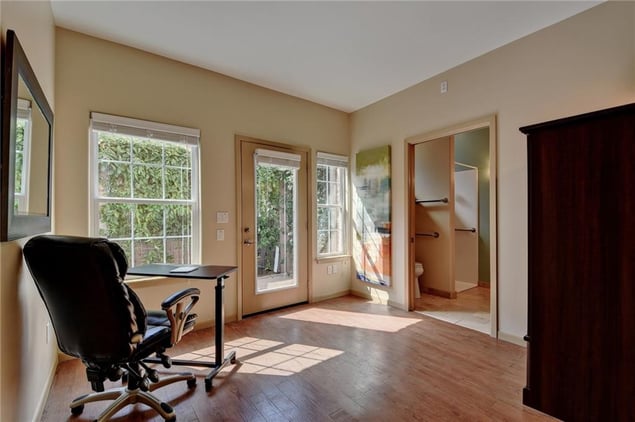
According to the AARP, 80 percent of older homeowners overwhelmingly prefer to Age in Place, which means living in a home safely, independently, and comfortably, regardless of age or ability level. People with disabilities are aging but healthy individuals are aging into a disability. Aging in Place strictly deals with the remodeling of existing homes. Therefore, to Age in Place, owners need to gradually modify their homes as they mature increasing access and safety using the principles of Universal Design before a life-changing event forces making sudden architectural changes. The Aging in Place market in the U.S. today is influenced by the increasing size of the aging population, the market desire to remain in one's home, a constantly increasing cultural diversity, and the aging housing stock associated with reduced affordability. The desire to remain in existing homes is driven by social attachments via a network of neighbors, friends, and family. Comfortable positive aging is a way of living rather than a state of being. What's more, seniors who took a proactive approach in modifying their homes over time offer peace of mind to their loved ones who know their family members are living safely and independently in their homes.

Clearly, the act of Aging in Place occurs during a period of time when mature homeowners or seniors have the ability to make decisions to better support an increased quality of life. There are three segments served within the Aging in Place marketplace. The first segment includes those homeowners without urgent needs. The second segment focuses on a group of homeowners with progressive health needs. The third sector involves those people who have undergone traumatic health changes or accidental injuries necessitating immediate modifications to the home. The choice to Age in Place does not mean the homeowner has to do everything in the future by themselves. Aging in Place principles supports responsible people living life with dignity and independence even when outside assistance is essential.
T-Square Company is one of Austin's premier Aging in Place contractors offering complete Aging in Place services from home assessments to design/builds. We have over 30 years of accessibility knowledge to share with our clients making their home life less complicated. We hold a nationally recognized CAPS certification (Certified Aging in Place Specialist) offered by the National Association of Home Builders, NAHB. Contact T-Square Company today to find out how to proceed toward an accessible second chapter of your life while remaining at home. We offer complete Aging in Place design services.

Tags:
aging in place remodeling,
aging in place home modifications,
aging in place home improvements in Austin,
accessible home remodeling,
aging in place services,
home modifications for independent living Austin,
universal design ideas,
certified aging in place consultant in Austin,
aging in place specialist in Austin,
universal design remodeling contractor,
7 principles of universal design,
applying principles of universal design in Austin,
barrier free remodeling,
universal design/build contractor,
why universal design,
what is universal design in Austin,
what is aging in place,
universal design techniques,
accessible home builder in Austin,
the basics of aging in place
Physical limitations affect many more people than the daily users of walkers and wheelchairs. Many members of our society experience a need for elder construction and disability remodeling having significant problems in dealing with their home environment. Today's conventional building standards conflict with most people's accessibility when you consider our created architectural barriers concerning cabinetry and door opening widths, individual strength, range of motion, movement, manual dexterity, balance, and coordination. Once the demands of our built environment exceed their capacities we become excluded from a room or even the entire home. The building world must work in unison to be sure the entire living environment meets basic needs in addition to affordability and structural integrity for the consumer and homeowner. This includes both the home and the components within the home being accessible to all inhabitants. Privacy, sense of belonging, sense of control, and the sense of safety and security make up the quality of life for any home and should be considered for any design.
The concept of successful aging has become increasingly important as senior citizens begin to dominate the population. An active engagement in life through participation in social and productive activities is one component of successful aging. The built environment directly impacts the engagement profiles of older adults so it is necessary to provide environments designed to suit the needs of aging adults. Of all the design theories that attempt to accommodate the aging process, Universal Design may be the most desirable option as it provides built environments that benefit everyone. Universal Design is a promising voluntary philosophy that requires increased attention from designers and builders participating in Aging in Place. Taken as a whole, it is evident that the application of Universal Design into the built environment is a positive step toward successful aging.

The new evolving concept known as Universal Design for home remodeling is catching on nationwide and has been for several years as a sign of the times. Universal Design principles used in building or remodeling make a home more accessible to all regardless of their mobility or adaptive abilities. Furthermore, the evolution of new products used for disability home modifications is making those homes more accessible and has finally come about in the remodeling industry. These new advances in accessible home remodeling in Austin not only keep the living environments safer but will not compromise the home's aesthetics. In fact, there are many benefits to using Universal Design techniques, including potential ease of use by aging family members, added resale value, and the fact that you'll be creating a space that can be used by anyone who visits your home, regardless of their range of abilities. Universal Design offers a clear path for Aging in Place within any home.
Simple Universal Design updates for Aging in Place home modifications and handicap accessibility can include adding grab bars or handrails throughout the home, adding a seat within the roll-in shower, lowering upper cabinets and countertops, adding non-slip flooring, widening hallways or installing stairlifts, and widening doors. You might also consider lowering light switches and thermostats and installing easier-to-use doorknobs. You should try to provide a clear barrier-free path or accessible route to the most visited areas of your home as recommended by the ADA. Remember that more open space gives room for maneuverability while using any mobility aid required.
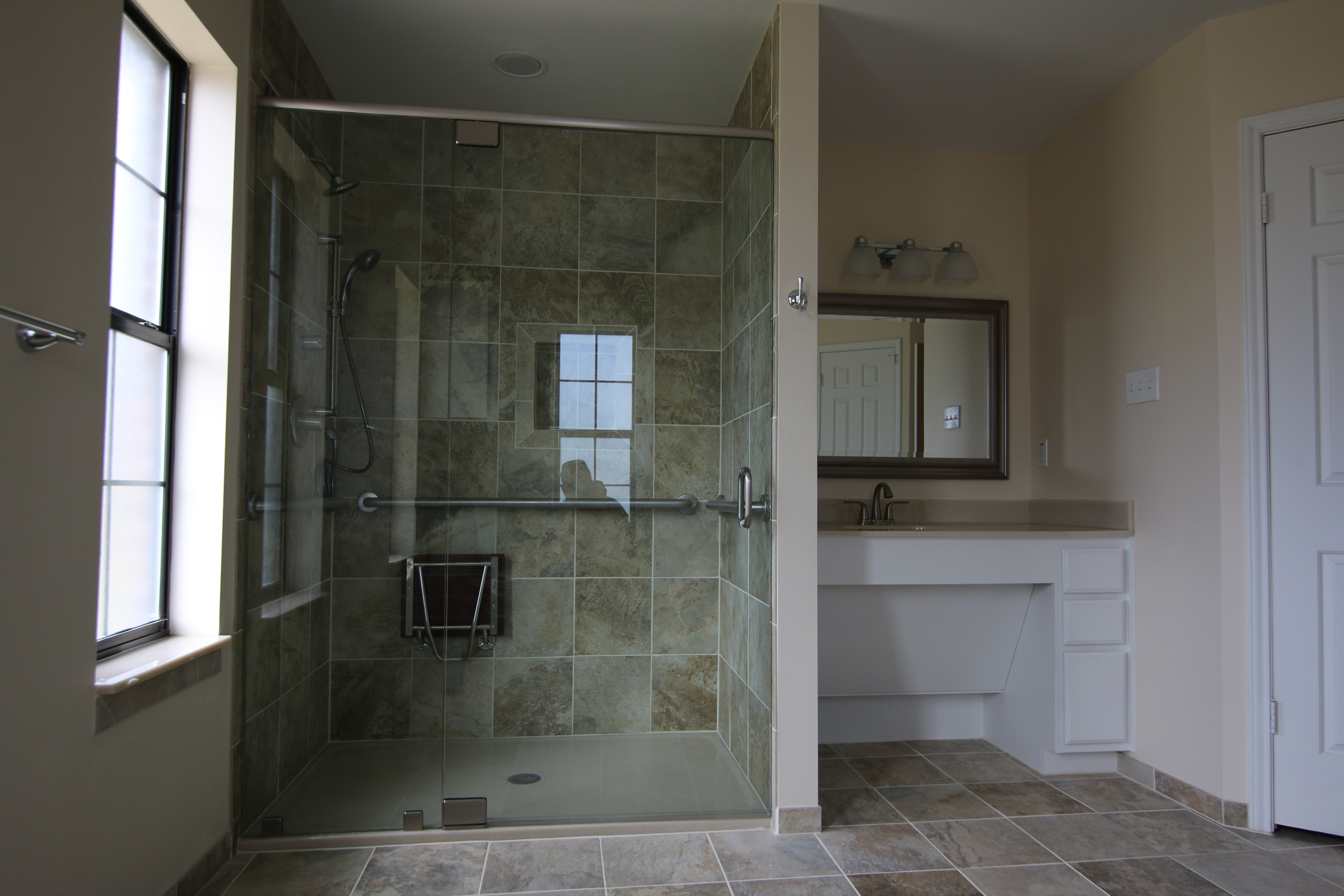
When mobility becomes an issue for any homeowner or family member, regardless of age, the question arises concerning physically moving to a different home on one level with at least a bath that is more accessible. Austin handicap remodeling can help in preparing for one of those highly likely events involving someone in your home needing room modifications for even a short time while recovering from surgery is surely a smart move. Solving Aging in Place issues will soon become the number one challenge concerning the present obsolete housing inventory in our country. Our present-day obsolete homes now inhabited by the baby boomer generation will slowly and increasingly raise their outdated and obsolete ugly heads and expose their true lack of accessibility to those very people inhabiting them. The situation will only become ever more expanding in time. When these homes were previously purchased, they represented an absolute castle in the world of their owners in which to prepare for a day and they also acted as a retreat from life's tough interactions. They housed our families, our memories, and our stuff. They represented a place where we could be ourselves. Our homes have always been exempt from any and all of the accessibility regulations that have been put in place since 1968 when our Viet Nam veterans were returning home.

Let's face it, accessible homes are needed by all of us at some time in our lives even for a short time. This is true whether it's for ourselves, a family member, or a guest. The need is certainly not driven by age but is a result of life's experience sometimes requiring wheelchair remodeling. Any family living with a disability among any of its generations within its group can always benefit from additional home accessibility.
Everyone ages differently and has different needs and wants. The factors that constitute the Aging in Place market for all individuals are based on a person's genetic makeup, their lifestyle including the choices they have made while living their life, and their environment. These factors have brought about the need for universal design principles. This is the design of products, services, and environments that are usable by as many people as possible regardless of age, ability, or situation without the need for adaptation or specialized alterations. It provides for the greatest safety and access for any home guests or occupants and is undetectable when done well. Since so very few homes share the accessibility offered by Universal Design, to satisfy the needs of a particular household member brought about by an accident, an illness, or simply the aging process there will always be a need for customized accessibility features. This will be accomplished by a CAPS accredited remodeling professional producing a truly functional design. This same competent home remodeling company that understands and practices accessible home modifications in Austin should carry out the work to fit the design and ensure your safety and accessibility. The criteria for home accessibility are not common knowledge among builders. It is acquired and practiced knowledge.
The National Association of Home Builders, in partnership with the AARP and Home Innovation Research Labs, created the CAPS program, which includes training and education on the technical, business management, and customer service skills essential to compete in the fastest-growing segment of the residential remodeling industry--home modifications for Aging in Place. David L. Traut, CAPS owner of T-Square Company in Austin, Texas is one of the select group of professionals nationwide to earn the Certified Aging in Place Specialist (CAPS) designation more than a decade ago, identifying him as a home remodeler and builder with the skills and knowledge necessary to remodel or modify a home to meet the unique needs of the older population, disabled owners or their visitors. We generate handicap accessible floor plans for our clients with special needs. Our design/build projects have helped countless homeowners through the VA, HUD, and the private sector. The home modifications we offer will in turn increase safety and independence for all involved as they go through life.
For additional information about the CAPS program, visit nahb.org/CAPS. For more information about T-Square Company, visit www.tsquareco.com or call 512-444-0097.

Tags:
aging in place home modifications,
custom tub to shower conversions,
barrier free remodeling,
disability remodeling,
handicap bathroom remodel,
accessible home remodeling for disabilities,
barrier free showers in Austin,
handicap ADA roll in shower,
wheelchair accessible shower stalls,
roll in shower,
ADA vanity in Austin,
wheelchair accessible toilets,
barrier free toilets,
handicap accessible toilets,
roll under vanity,
home remodeling near me,
home remodeling professional,
accessible bathroom remodel,
specialty construction in Austin,
professional construction services in Austin,
wheelchair ramp specifications,
Austin shower remodel,
bathroom remodel contractors near me,
why universal design,
wheelchair accessible housing,
accessible housing,
handicap accessible house plans,
accessible homes in austin,
handicap bathroom contractor in Austin,
handicap accessible floor plans,
accessible home builder in Austin,
wheelchair accessible homes,
special needs contractor,
universal home design in Austin,
home renovations for disability in Austin,
disability remodeling contractor in Austin,
Professional Disability Remodeling Contractor,
disability home remodeling near me
What are CAPS services and what does CAPS stand for? First of all, CAPS stands for Certified Aging in Place Specialist. The aging societal changes and inventory of inaccessible existing houses created the need for a CAPS certification program. This designation program, offered through the National Association of Home Builders, NAHB, in collaboration with The American Association of Retired Persons or AARP, incorporates components of assessment, technical knowledge, and management skills related to home modifications used to help people stay at home safely and independently for a longer period of time. The program was developed in 2001.
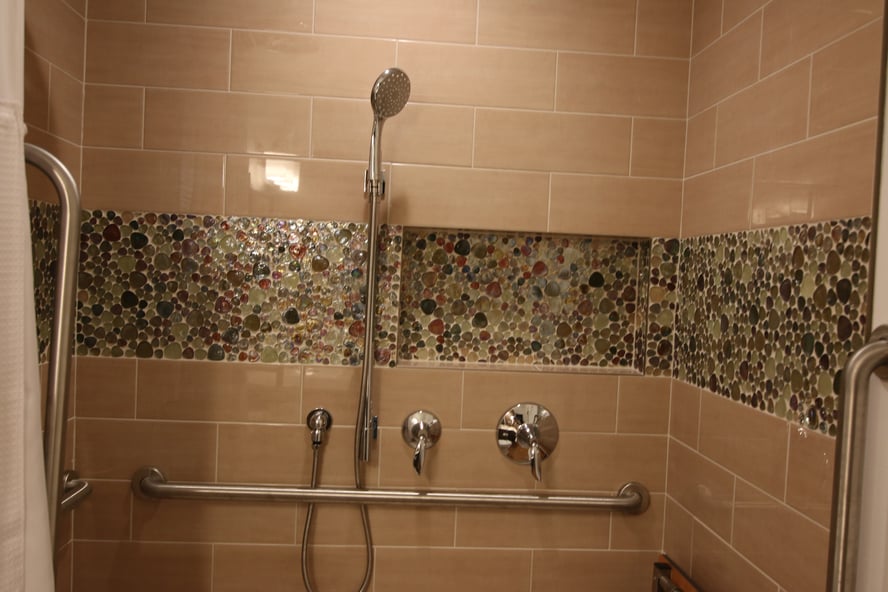
The services offered by a CAPS professional varies from a complete accessible remodel to improving certain areas in the home like bathrooms or kitchens. The precise modifications increase usability according to personal needs of the homeowner and family. The CAPS program connects responsible professionals with homeowners needing specialized accessibility services on an ever-increasing basis. Ordinary homeowners with extraordinary challenges partner up with experienced CAPS professionals and their own families. Working as a team, the trained CAPS specialist along with any family caretakers or therapists is able to identify the day-to-day problems weighing on those with health limitations. Aging in Place services provided by a specialized remodeling contractor ensures all accessibility issues of the home are accomplished correctly. T-Square Company located in Austin, Texas is one of the specialized CAPS certified contractors.
The CAPS credential is a nationwide initiative and many construction and design professionals are taking advantage of the helpful training across the nation. David L. Traut, president, and owner of T-Square Company is an active CAPS member (#1636580) and has participated in the program for over a decade. Furthermore, he has actively completed accessibility design/build remodels for over 25 years for the private sector, HUD, and the VA. Always check a person's credentials to verify the remodeler holds an active CAPS certification and is familiar with Universal Design. All registered CAPS program graduates and remodeling companies are listed in a national registry in Washington DC. The information is found by calling 1-800-368-5242 or by simply visiting their website at: http:www.nahb.org/en/learn/designations/certified-aging-in-place-specialist.aspx.

If the current pandemic taught us anything concerning safety and institutional living situations, we now know it is much safer to remain in your home surrounded by familiar surroundings and friends. During the stay-at-home mandates, everyone was aware of what Aging in Place meant. We all became better acquainted with our homes and family members. The best way to approach a desire to Age in Place is by being proactive before an illness takes control of your life. At that point, you must deal with it in a reactive manner. There are many differences between home modifications and a home remodel. The main difference is home modifications involve investing in your familiar home versus spending during remodeling. Home modifications are used to enhance your ADL (Activities of Daily Living) whereas remodeling deals more with aesthetics. Investing in your home will benefit your future retirement years by making your home conform to your needs.
T-Square Company in Austin, Texas is a CAPS certified remodeler and offers design/build Aging in Place projects using principles of Universal Design. Call 512-444-0097 to discuss your project today and learn how you can achieve better accessibility within your existing home. Our knowledge and experience can help solve your personal needs within your existing home. Whether you need a safer shower, wider doorways, a zero-step entrance, or a more accessible kitchen to entertain your family and friends, T-Square Company is here to help.
Tags:
barrier free access,
aging in place remodeling,
CAPS,
aging in place home modifications,
ADA compliance,
custom tub to shower conversions,
accessible home remodeling,
CAPS remodeling techniques,
aging in place services,
bathroom modifications for disabled,
ADA bathroom Austin, Texas,
home modifications for independent living Austin,
Austin Handicap Remodeling,
universal design ideas,
certified aging in place consultant in Austin,
universal design remodeling contractor,
handicap accessible remodeling,
barrier free remodeling,
disability remodeling,
handicap accessible bathroom shower,
veterans home remodeling in Austin, Texas,
veterans home accessibility help in Austin, Texas,
accessible toilets,
ADA Compliant grab bars,
home access,
what is aging in place,
accessible home builder in Austin,
ADA Compliant Bathroom Vanity,
the basics of aging in place,
universal design home additions
The present out of control housing market situation prompted a search for answers solving the question of how to create houses capable of meeting the needs of tomorrow while accommodating future life changes. There is no one size fits all home design because everyone’s life experience is unique to them creating a diverse society with diverse physical needs. Using Universal Design, the wide ranging abilities of the homeowner is a major consideration for all successful inclusive and adaptable designs in homes. The absence of the Universal Design principles entering into all existing home architectural endeavors is perpetuating the lack of accessible housing urgently needed for the lifespan of every homeowner. To increase the acceptance of this design concept by everyone, especially the consumer, Universal Design must become a topic of conversation through knowledge and basic understanding. This depends on the members of the broadest populations’ acknowledgement of the need for the use of this practical idea.

Universal Design plays a significant role in the future accessibility of all home designs. Homeowners must base design decisions on the seven (or eight) principles of Universal Design. Deciding which universal features to include in future forever homes is the most alluring question. Each principle is very useful in itself. The more principles involved in the design process, the greater the adaptable outcome of the home. After all, the smart forward thinking homes of the future depict long term sustainable assets for life allowing Aging in Place to seamlessly follow as people age and evolve. It is true Universal Design emerged out of the accessible and adaptive architectural movement; however, it constantly attempts to combine aesthetics with basic core values for every user. While moving us toward an accessible future, appearing invisible, Universal Design recognizes peoples’ bodies, needs, and lifestyles constantly change along a continuum due to the aging process. Universal Design acknowledges too that everyone ages differently as individuals. One person’s disability type is not experienced like another’s. It is better to live in a more open and comfortable Universal Design home with the flexibility of evolving with the homeowner rather than one which at some uncertain time becomes an impasse during the homeowner’s lifetime.

Embracing Universal Design with its many values and advantages for all people during timely remodeling projects or while building a new home is needed if society is ever going to escape the inaccessible cookie cutter homes of today. Additionally, this design technique offers a win-win solution helping solve problems encountered by multi-generational households. The multi-generational homes of today create the greatest personal accessibility challenges for all the generations involved. The application of Universal Design principles is desperately needed to sustain the choice of living environments for these diversified families. Universal Design homes have the unique ability of simultaneously accommodating strollers, walkers, or wheelchairs within the home without regard to a person’s size, age, or abilities. Furthermore, these homes contain lasting value if the owner ever decides to sell appealing to all society groups. To the uninformed, the folklore associated with Universal Design has stigmatized the process in home building today. This has much to do with why such a unique building concept is not greeted with open arms by the consumer. Beliefs like, it costs more, it takes up too much space, it will make my home have less resale value, it will look institutional, or only a few people could benefit from it represent a select few.
While Universal Design sounds appealing in conversations, it is rare to actually witness it in the built environment. The Universal Design movement recognizes its slow acceptance hinges on historic ties related to being a disability solution. This way of thinking causes implications for consumers and the world of home design presenting a huge misconception. Universal Design never distanced itself from the need for increased accessibility during the disability movement of the 80’s and therefore is mired in ADA jargon producing an indelible unfocused brand. As an inclusive design, Universal Design pertains to overcoming the barriers and stereotypes associated with its terminology in order to stand out as the next and final trend in future housing. Universal Design has no limits for the varying groups of people it helps. Every family member is included when using this design methodology whether they are abled or disabled, short or tall, young or old. With education, people understand Universal Design is the most revolutionary element in housing design today. Once realized how the principles of Universal Design affect everyone in the quest for maximum inclusion, consumers might start paying better attention to this logical building concept. Future home dwellers are fortunate in having this transitional and adaptable design concept in their vocabulary. Possibly they distinguish the designs flexibility as the gateway for tomorrow homes built and designed for everyone at every age. Only then, when people grasp the importance of Universal Design, does it become an everyday building term and a much needed household solution. No longer are personal desires for Aging in Place creating total disruption during life’s waning years. It is successfully accomplished seamlessly following the accessibility offered by Universal Design.

Tags:
ADA compliant kitchen cabinets,
accessible routes,
barrier free access,
wheelchair accessible baths and kitchens,
CAPS certification,
custom walk in showers,
ADA kitchen cabinets,
wheelchair accessible baths,
CAPS professional in Austin,
Universal Design,,
aging in place specialist,
aging in place design,,
handicap accessibility,
roll in showers,
accessibility designs Austin Texas,
roll in showers in Austin,
universal design/build,
universal design ideas,
Austin Accessibility Design,
certified aging in place consultant in Austin,
aging in place specialist in Austin,
universal design building for a lifetime,
what is universal design,
home accessibility help in Austin,
universal design kitchen ideas,
universal design remodeling techniques,
universal design remodeling contractor,
why is universal design important,
universal design principles,
7 principles of universal design,
universal principles of design,
Universal Principles of design revised and updated,
principles of universal design,
applying principles of universal design in Austin,
special needs contractor in Austin,
disability and special needs contractor Austin,
bathrooms with disability access in Austin, Texas,
ADA compliant wheelchair accessible showers,
disability access contractor,
barrier free showers in Austin,
ADA compliant roll in showers,
wheelchair accessible shower stalls,
roll in shower,
accessible bathroom design specifications,
wheelchair accessible toilets,
barrier free toilets,
handicap accessible toilets,
what is ada compliant,
home access,
accessible homes,
home access in Austin,
universal design/build contractor,
universal design vs. aging in place,
universal design contractor,
accessible design,
why universal design,
wheelchair accessible housing,
handicap accessible housing,
accessible homes in austin,
accessibility home modifications,
wheelchair accessible bathroom,
handicap bathroom design,
modifying your home for a disabled child,
accessible home builder in Austin,
wheelchair accessible homes,
universal home design in Austin,
the basics of aging in place,
how the life cycle affects aging in place,
applying universal design,
maneuvering in and around the accessible home,
Universal Design Garages,
Universal Bathroom Design,
Universal Design Bedroom,
universal kitchen design,
wheelchair accessible kitchens,
universal design kitchen,
barrier free kitchens,
disability access kitchens,
the universal design laundry,
barrier free laundry,
future home building using universal design,
universal design home builder,
universal design home additions,
barrier free design,
barrier free home design
Accessible bedrooms are important for people with or without disabilities and for anyone planning to Age in Place. A functional accessible bedroom involves basic Universal Design principles to accommodate future needs. This endeavor ensures access to everyone regardless of their age, abilities, or size. Using Universal Design in the bedroom guarantees everything is easy to see, in reach, and most importantly, easy to approach. Going from the bathroom to the bedroom involves the shortest distance allowed without turns if possible. Traveling from the accessible bedroom through a 36 inch wide door provides access into the designated accessible bathroom. The size of the targeted bedroom dictates the furniture layout. Determine the best furniture placement allowing a clear five foot turning radius inside the bedroom.
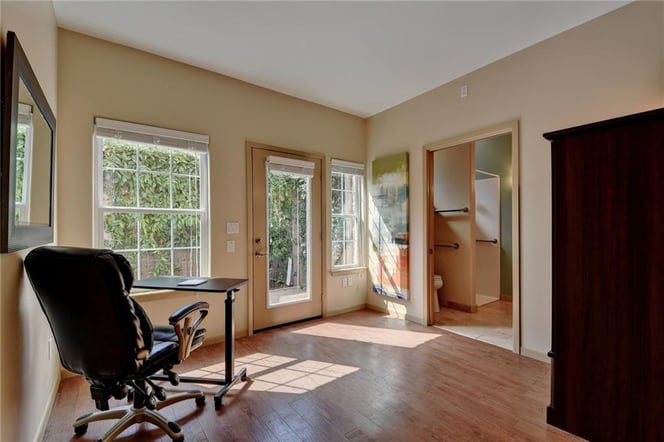
Arrange furniture producing a clear unobstructed 36 inch wide path and prevent clutter. Visualize moving around in the bedroom while approaching the closet utilizing a 30 x 48 inch clear space overlapping with the turning radius area. Always avoid clutter using too much furniture causing interference and trip hazards.

The closet and dressing area are part of the bedroom. When feasible, open shelf and drawer storage for non-hanging items provide the greatest accessibility in the closet. Built in pull out shelves and drawers are installed below the 48 inch rod/shelf location for specific storage. Fixed shelves or a pull down rod is installed as a storage solution above the 48 inch rod/shelf. Clothes carousels and automated shoe storage units provide further options for the closet. Automated shoe storage units provide an option to regular stationary shoe storage providing greater storage capacity. In any good Universal Design bedroom the lighting, color finishes, and flooring are specified correctly ensuring increased safety and ease of use concerning everyone using the bedroom. The end result is functional and beautiful as well as spacious creating a feeling of openness.

Tags:
barrier free access,
aging in place remodeling,
aging in place services,
disability home modifications in Austin,
home modifications Austin, Texas,
accessibility designs Austin Texas,
home modifications for independent living Austin,
universal design/build,
universal design ideas,
universal design/build ideas,
aging in place specialist in Austin,
home modifications for children with disabilities,
universal designbuilding for the future,
home accessibility help in Austin,
universal design remodeling contractor,
universal design building contractor,
universal principles of design,
applying principles of universal design in Austin,
special needs contractor in Austin,
barrier free remodeling,
handicap accessible home modifications,
disability remodeling,
veterans home remodeling in Austin, Texas,
home access,
universal design/build contractor,
universal design contractor,
home accessibility,
accessible design,
what is universal design in Austin,
accessible housing,
accessible homes in austin,
universal design techniques,
accessibility home modifications,
wheelchair access,
accessible home builder in Austin,
disability renovation services in Austin Texas,
applying universal design,
Universal Design Bedroom
The number one safety hazard for elderly or disabled people of any age is negotiating level changes both outside and within the home--steps at the entry, stairs between floors, curbs to step over when entering the bath or shower, and being able to access patios, decks, and terraces. When Universal Design is correctly incorporated into a home’s layout, these flexible houses accommodate the needs of their owners and their visitors even as those needs evolve over time. Barrier free homes are functional and comfortable as well as accessible to everyone.
Visitability or the lack thereof begins at the curb for every home. This term refers to how easy it is for all people coming by to pay a visit or stay with the homeowner regardless of their physical abilities. Occupants and visitors are capable of entering an accessible bathroom located on the same floor representing the visitability of the home. Ideally, the entry into the house is through a 36 inch wide door having an ADA threshold to create a no step entry. Entrance is obtained using an easily graspable lever style lock.

The accessible entrance is a great place to begin an accessible route for most homes. Once inside the structure a new set of problems concerning accessibility are discovered along the extended accessible route if the entire first floor is not on one single level. The designated accessible route continues into all of the most used rooms increasing accessibility. All swinging doors are minimally 36 inches wide using Universal Design along the accessible route producing a clear 32 inch wide opening when the door is opened to ninety degrees. Sliding, pocket, and bi-fold doors require less operating approach space because the door is better contained along the wall in which it is mounted.
With increasing age or following a temporary health setback, simply maneuvering around inside the home is increasingly more difficult. This designated route includes a 5 x 5 foot clear turning space required for wheelchairs in the main living area, kitchen, the bedroom, and one bathroom. The selection, placement, and design of doors and doorways influence a wide range of people. The location of the doorways affects furniture placement and usable space within the associated room. This in turn affects the clear floor space and usability of the living environment for someone confined to a wheelchair utilizing the accessible route.

Tags:
barrier free access,
aging in place remodeling,
aging in place,
aging in place home improvements in Austin,
aging in place remodels,
accessible home remodeling,
Universal Design,,
home modifications for independent living,
aging in place specialist,
aging in place services,
aging in place design,,
certified aging in place specialist,
handicap remodeling contractors in Austin,
disability home modifications in Austin,
handicap accessibility,
accessibility remodelers in Austin,
home modifications for independent living Austin,
disability remodeling in Austin,
Austin Handicap Remodeling,
universal design/build,
universal design ideas,
Austin Accessibility Design,
Austin accessible home remodeling,
certified aging in place consultant in Austin,
aging in place specialist in Austin,
aging in place design in Austin,
age in place home design,
what does it mean to age in place,
what is universal design,
aging in place home remodeling,
home accessibility help in Austin,
home remodeling for disabled in Austin Texas,
wheelchair accessible home remodeling in Austin,
universal design remodeling techniques,
universal design remodeling contractor,
universal design building contractor,
universal design principles,
applying principles of universal design in Austin,
disability contractor in Austin,
disability and special needs contractor Austin,
Austin disability contractors for special needs,
handicap accessible remodeling,
barrier free remodeling,
handicap remodeling,
disability remodeling,
disability access contractor,
home access,
universal design vs. aging in place,
universal design contractor,
home accessibility,
accessible design,
why universal design,
what is universal design in Austin,
wheelchair accessible housing,
handicap accessible housing,
accessible homes in austin,
universal design techniques,
accessibility home modifications,
accessible home modifications,
modifying your home for a disabled child,
handicap accessible floor plans,
accessible home builder in Austin,
wheelchair accessible homes,
special needs contractor,
universal home design in Austin,
home renovations for disability in Austin,
disability remodeling contractor in Austin,
disability renovation services in Austin Texas,
the basics of aging in place,
how the life cycle affects aging in place,
aging in place versus universal design,
maneuvering in and around the accessible home
Along with the exponential birth rate of the baby boomers in the late 40’s and 50’s, the need for more housing created sprawling American suburbs to accommodate the growing families. Developments sprang up with few architectural options while affordability was the main concern. Today, these same homes slowly and increasingly signify outdated and obsolete architectural barriers exposing a true lack of accessibility for the very people inhabiting them. The situation is ever more expanding in time because the greatest majority of individuals want to age where they currently reside. This basic desire is creating unprecedented nationwide challenges and a niche market in the remodeling industry known as Aging in Place. The majority of Americans over the age of 45 want to continue living in an environment they are well acquainted with throughout the maturing years. Everyone is living longer only to experience many life challenging events during an extended lifespan.

According to the AARP, 80 percent of older home owners overwhelmingly prefer to Age in Place, which means living in a home safely, independently and comfortably, regardless of age or ability level. People with disabilities are aging but healthy individuals are aging into a disability. Aging in Place strictly deals with the remodeling of existing homes. Therefore, to Age in Place, owners need to modify their home as they mature increasing access and safety using Universal Design before a life changing event forces making sudden architectural changes. The Aging in Place market in the U.S. today is influenced by the increasing size of the aging population, the market desire to remain in one's home, a constantly increasing cultural diversity, and the aging housing stock associated with reduced affordability. The desire to remain in existing homes is driven by social attachments via a network of neighbors, friends, and family. Comfortable positive aging is a way of living rather than a state of being. The three main areas needing improvement for a person wanting to Age in Place is the bathroom, the kitchen, and the family area in that order.
Clearly the act of Aging in Place occurs during a period of time when seniors have the ability to make decisions to better support quality of life. There are three segments served within the Aging in Place marketplace. The first segment includes those homeowners without urgent needs. The second segment focuses on a group of homeowners with progressive health condition needs. The third sector involves those people who have undergone traumatic health changes or accidental injuries necessitating immediate modifications to the home. The choice to Age in Place does not mean the homeowner has to do everything in the future by themselves. Aging in Place principles support responsible people living life with dignity and independence even when outside assistance is essential.

Tags:
aging in place remodeling,
aging in place home modifications,
aging in place home improvements in Austin,
accessible home remodeling,
aging in place services,
home modifications for independent living Austin,
universal design ideas,
certified aging in place consultant in Austin,
aging in place specialist in Austin,
universal design remodeling contractor,
7 principles of universal design,
applying principles of universal design in Austin,
barrier free remodeling,
universal design/build contractor,
why universal design,
what is universal design in Austin,
what is aging in place,
universal design techniques,
accessible home builder in Austin,
the basics of aging in place
It is very evident the current home inventory lacks the ability of accommodating more than a third of the consumers inhabiting them. Traditional home builders never considered the accessibility issues affecting mobility for the homeowner or visitor. Consumers have allowed the built environment to mandate the inhabitant’s capabilities for far too long. In 2020, all the 76 million baby boomers reach the age of 55 or older at a time when many people are planning for retirement. This perpetual problem, brought on by years of endless supply and demand, is finally being acknowledged by our ever aging population. Traditional home builders never considered the accessibility issues affecting mobility for the homeowner or visitor. Once any disability occurs to the homeowner or family member regardless of age, size, or ability, including a broken limb, the same home endeared for at least part of a lifetime becomes a prison presenting unforeseen barriers, frustrations, and perils at every turn. This situation is not age related but is a function of life experience. Because consumers have allowed the built environment to mandate the inhabitant’s capabilities for far too long, the only way people are capable of remaining in the home is through home modifications. Home modifications using the concept of Universal Design ensures all people at every stage of life and ability benefit from an inclusive surrounding living environment. Universally, any family living with a disability among any of its generations benefits from additional accessibility. The early application of Universal Design concepts within the home offer practical solutions to cope with future unforeseen problems experienced at any time throughout life.

Disease is not necessarily a part of aging. Genetics and more commonly the environment dictate when disease is expressed. The five senses are burdened by age as a result of cellular degeneration constantly altering the way the world is perceived. This ongoing aging process begins at birth. How rapidly it occurs is defined by an individual’s personal makeup. Encountering problems with memory, agility, taste, hearing, smell, or vision during the aging process alters the way the living environment is perceived and conforms to the needs of any homeowner. This situation holds true for a younger adult suffering from a debilitating disease or returning to health following an accident. The scenario is once again verified for a teenager or a young child experiencing a life changing accident or illness. Hence, every member of society is included in the lack of home accessibility.
While the usual aging process affects daily activities at an increasing level over time, the early application of Universal Design concepts within the home offer practical solutions to deal with future unforeseen problems experienced at any time in life. The home is smartly prepared in advance to Age in Place and avoids drastic architectural changes due to a sudden physical need. This universal proactive design approach ensures the home does not contribute negatively to the adverse effects brought on by disability at any age allowing homeowners to seamlessly Age in Place.

Tags:
barrier free access,
aging in place remodeling,
aging in place home modifications,
aging in place home improvements in Austin,
Universal Design,,
aging in place services,
certified aging in place specialist,
home modifications for independent living Austin,
universal design ideas,
aging in place specialist in Austin,
home remodeling for disabled in Austin Texas,
universal design remodeling contractor,
universal design building contractor,
7 principles of universal design,
applying principles of universal design in Austin,
handicap accessible remodeling,
barrier free remodeling,
disability remodeling,
disabled bathroom remodel,
home access,
why universal design,
universal design techniques,
accessible home builder in Austin,
how the life cycle affects aging in place
Traditionally bathroom vanities were constructed so the finished cabinet top was 30” AFF (above finished floor). This meant that taller people had to bend over and stand away from the sink in order to use it. This puts added stress on the lower back and legs diminishing the comfort factor. Typically bathroom vanities are 21" deep and approximately 29" tall. The depth is not a problem but most folks would prefer a universal design height of 34". Universally, sinks shouldn't be mounted higher than 34 inches from the floor to the top of the cabinet top for an under mount or drop in model. The sinks should not exceed six inches in depth and should be installed within three inches from the front of the overhanging cabinet top edge. The ADA vanity cabinet or even a simple wall hung sink should have a knee clearance below of 27 inches high and be at a minimum 32 inches wide by 11-25 inches deep. The choice of sink styles depends on the personal preference of the user. Be sure the lavatory controls are easily controlled with lever or paddle handles and are capable of being operated with one hand and not requiring tight grasping, pinching, or pinching of the wrist. Knobs, discs, or ball type handles can be hard to operate by anyone with soapy hands and more so by someone having an arthritic condition or other ailments. The closer the sink valves can be located toward the front of the sink the better. This can be accomplished by following the curved outline of the sink.
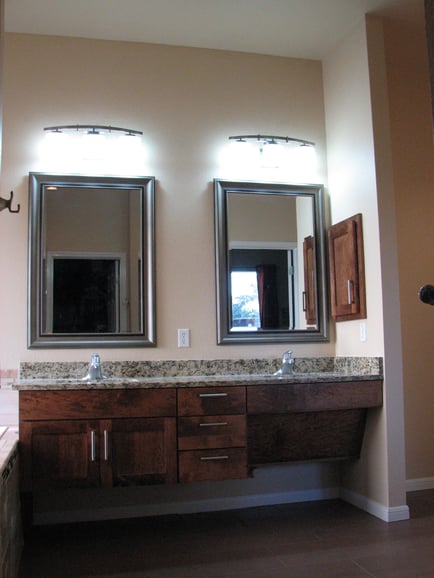
There are basically two styles of ADA vanities that comply with an unobstructed roll under area below the sink. This capability has everything to do with both the water supply lines and the main waste line connecting the sink. There must be provisions made to protect the user from being scalded when coming into contact with any one of the plumbing pipes serving the sink. These connecting pipes may become heated merely by the water passing through them creating a problem of scalding the user especially if they are unable of feeling sensations. The open type model should always receive both waste and supply insulating jackets applied directly to the pipes providing protection for the wheelchair user. The closed model concealing the pipes will be equipped with a removable face or panel board covering the pipes. This pipe concealing panel must be installed at the correct angle. This allows for the needed unobstructed legroom required for the user. The vanity can extend beyond the sink but the area containing the sink is required to have this roll under capability which is 27" tall and 32" wide. This section of the vanity top must not be any taller than 34 inches above the finished floor with the sufficient lower clearance mentioned above. Clear unobstructed reach distances around the counter top area must be observed at 24 inches. Any motion controlled sensors integrated into the various dispensing devices and/or plumbing fixtures throughout the bathroom present a true hands free benefit to all the bathroom users. If these aren't in the budget then at least wrist handles used for controlling the faucet can be incorporated into the design of the vanity. Bathroom vanities with 34" universal height cabinet tops and open knee spaces are taking over the marketplace. These new residential vanities do not need to look institutional. They can be designed like any other piece of fine furniture.
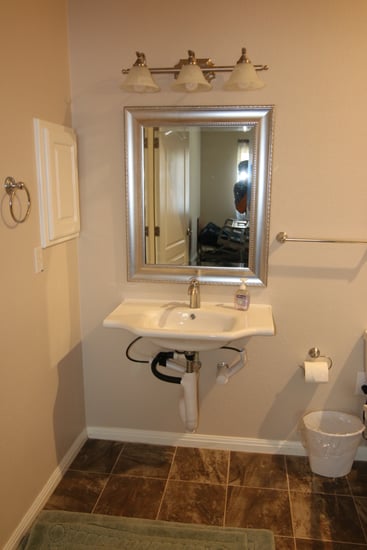
Recommended Clear Dimensions And Requirements
Sinks shouldn't be mounted higher than 34 inches from the floor to the top of the cabinet top for an under mount or drop in model. The sinks should not exceed six inches in depth and should be installed within three inches from the front of the overhanging cabinet top edge. A rear drain is recommended to have the proper clearance when rolling under the vanity. The ADA vanity cabinet or even a simple wall hung sink should have a knee clearance below of 27 inches high and be at a minimum 30 inches wide by 11-25 inches deep. A 9" high clear kick area (by 6" deep) at the floor should be maintained for a full height cabinet and be approximately ten inches deep according to the cabinet depth. Remember twenty four inches is the maximum reach distance while sitting in a wheelchair. Be sure the lavatory controls fall within this range and are easily controlled being operated with one hand and not requiring tight grasping, pinching, or pinching of the wrist.
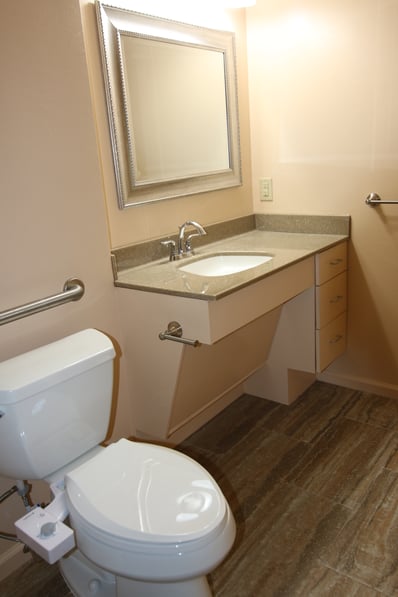
Clear Floor Space
To assure a clear floor space the lavatory must be installed at 24" from any side wall measuring from the center of the sink. The distance from one sink to another if using a double lavatory layout should be at least 30" center to center. In the case of wall hung freestanding sinks the minimum distance between them should be 4" between the sink edges.
A clear floor space of 30 by 48 inches must be provided to access all bathroom fixtures and these areas can overlap one another. The adjoining and overlapping wheelchair turning space should be an unobstructed sixty inches in diameter. A wheelchair turning space could utilize a T-shaped space considering a sixty inch square having two 12"x 24" areas removed from each corner of the square from the same side. This will be a 36" wide base with two 36" wide arms. T-shaped wheelchair turning spaces can include on one arm. In this case the clear width at the cabinet should be 36" to use the space as part of the T-turn.

Let's face it, accessible homes are needed by all of us at some time in our lives. This is true whether it's for ourselves, a family member, or a guest. The need is certainly not driven by age but is a result of life's experience. Any family living with disability among any of the generations within it's group can always benefit from additional accessibility. This will in turn increase safety and independence for all involved as they go through life.
Aging in place home modifications are available through T-Square Company. We are a certified aging in place (CAPS) specialist. Each design/build situation will be customized to fit your personal needs. Call 512-444-0097 today to begin the accessible second chapter of your life while remaining safe and secure in your existing home. CAPS #1636580

Tags:
disability remodeling,
handicap access bathroom remodel,
disability access contractor,
accessible home remodeling for disabilities,
ADA vanity in Austin,
roll under vanity,
what is an ADA compliant bathroom,
universal design/build contractor,
Austin home remodeling for disabled,
accessible home modifications,
wheelchair accessible bathroom,
handicap bathroom design,
handicap bathroom requirements,
handicap bathroom sink,
handicap bathroom vanity,
wheelchair access,
handicap bathroom contractor in Austin,
accessible home builder in Austin,
wheelchair accessible homes,
special needs contractor,
home renovations for disability in Austin,
disability remodeling contractor in Austin,
what is the height of a handicap vanity?,
disability renovation services in a,
disability renovation services in Austin Texas,
ADA Compliant Bathroom Vanity
ADA guidelines state that accessible sinks shouldn't be mounted higher than 34 inches above the floor for adults. For children, the sink should be set at 29 inches maximum above the finished floor. Both these heights are dependent on the individual using the sink and are truly a set of guidelines. Adults should have a knee clearance of 27 inches high by 30 inches of width with 11-25 inches deep. For children or smaller adults, a knee clearance of 24 inches above the floor is recommended. All sinks for the handicapped user should have no more than a 6 1/2 inch depth.There should also be a clear associated floor space for approach in front of the vanity which measures 30 by 48 inches. This clear space is needed to approach all bathroom fixtures and the clear spaces can overlap within the bathroom design. To assure a clear floor space the lavatory must be installed at 24" from any side wall measuring from the center line of the sink. The distance from one sink to another if using a double lavatory layout should be at least 30" center to center. In the case of wall hung freestanding sinks the minimum distance between them should be 4" between the sink edges. A clear 24 inch reach distance must be observed to help assist a seated person.
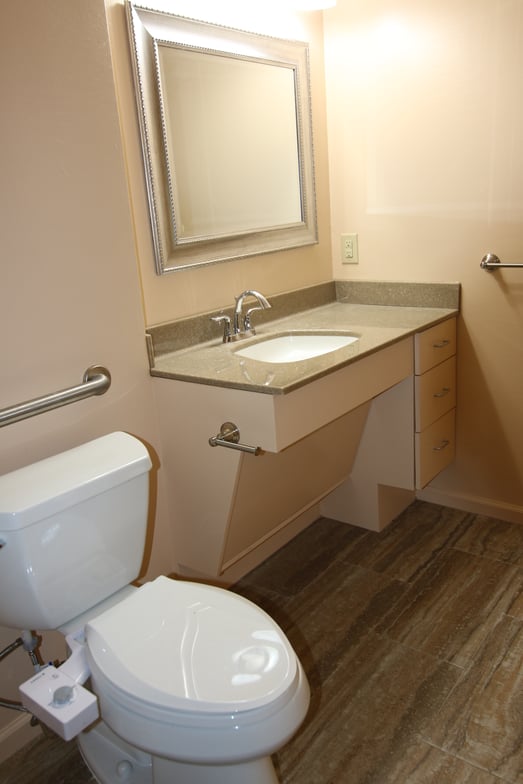
There is no one set of dimensions which works for everyone with special needs since everyone is different. Bathroom cabinets in Austin vary by style and usability needs. There are basically two styles of ADA bathroom vanities that comply with an unobstructed 27" tall roll under area below the sink. ADA sinks with a rear drain location provide for better plumbing drain hook ups. This modification has everything to do with both the water supply lines and the waste line connecting the sink. There must be provisions made to protect the user from being scalded when coming into contact with any one of the plumbing pipes serving the sink. These connecting pipes may become heated merely by the water passing through them creating the problem. The open type model should always receive both waste and supply insulating jackets applied directly to the pipes providing protection for the wheelchair user. The closed model concealing the pipes will be equipped with a removable face or face board covering the pipes. This pipe concealing panel must be installed at the correct wheelchair user clearance angle. This allows for the needed unobstructed legroom required for the user. The vanity can extend beyond the sink but the area containing the sink is required to have this roll under capability. This section of the vanity top must not be any taller than 34 inches above the finished floor with sufficient lower leg clearance. Clear unobstructed reach distances around the counter top area must be observed. Any motion controlled sensors integrated into the various dispensing devices and/or plumbing fixtures throughout the restroom present a true hands free benefit to all the restroom users. If these aren't in the budget then at least wrist handles used for controlling the faucet can be incorporated into the design of the vanity. Furthermore, automatic flush valves should be used on all toilets and urinals that provide for hands free use.

Finding a disability contractor familiar with the guidelines of Elder construction and accessibility for people with special needs can be quite difficult. Be sure to check out the credentials of any potential bidders you contact. Also be sure they understand that the alterations you are seeking are for wheelchair accessible home remodeling and modifications. Furthermore be sure this person knows and practices both the federal and most importantly your state's requirements before entering into any contract. We offer complete handicap accessible floor plans generated around our individual clients.
Aging in place home modifications are available through T-Square Company. We are a certified aging in place (CAPS) specialist. Each design/build situation will be customized to fit your personal needs. Call 512-444-0097 today to begin the accessible second chapter of your life while remaining safe and secure in your existing home. CAPS #1636580
Let's face it, accessible homes are needed by all of us at some time in our lives. This is true whether it's for ourselves, a family member, or a guest. The need is certainly not driven by age but is a result of life's experience. Any family living with disability among any of the generations within it's group can always benefit from additional accessibility. This will in turn increase safety and independence for all involved as they go through life.

Tags:
remodeling for elders in Austin,
disability and special needs contractor Austin,
Austin disability contractors for special needs,
handicap remodeling,
disability remodeling,
handicap access bathroom remodel,
handicap bathroom remodel,
disability access contractor,
veterans home remodeling in Austin, Texas,
ADA vanity in Austin,
ADA vanity height,
roll under vanity,
specialty construction in Austin,
home access in Austin,
bathroom remodel contractor,
home accessibility,
accessible design,
wheelchair accessible housing,
accessible housing,
handicap accessible housing,
handicap accessible house plans,
accessible homes in austin,
Austin home remodeling for disabled,
accessibility home modifications,
accessible home modifications,
wheelchair accessible bathroom,
handicap bathroom design,
handicap bathroom requirements,
handicap bathroom sink,
handicap bathroom vanity,
modifying your home for a disabled child,
handicap bathroom contractor in Austin,
accessible home builder in Austin,
wheelchair accessible homes,
special needs contractor,
home renovations for disability in Austin,
disability remodeling contractor in Austin,
what is the height of a handicap vanity?


















